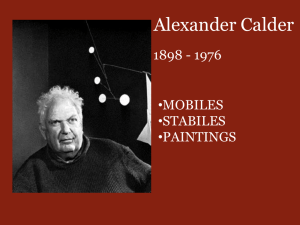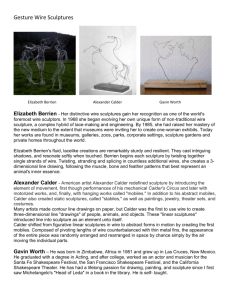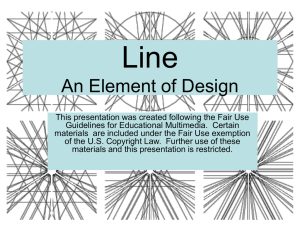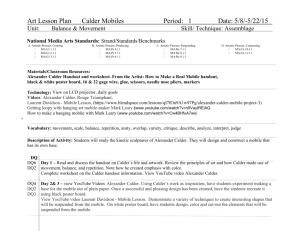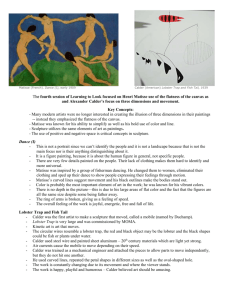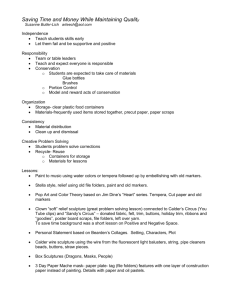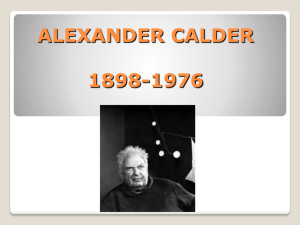Alexander Calder: A Balancing Act: Pre-Visit Activity
advertisement
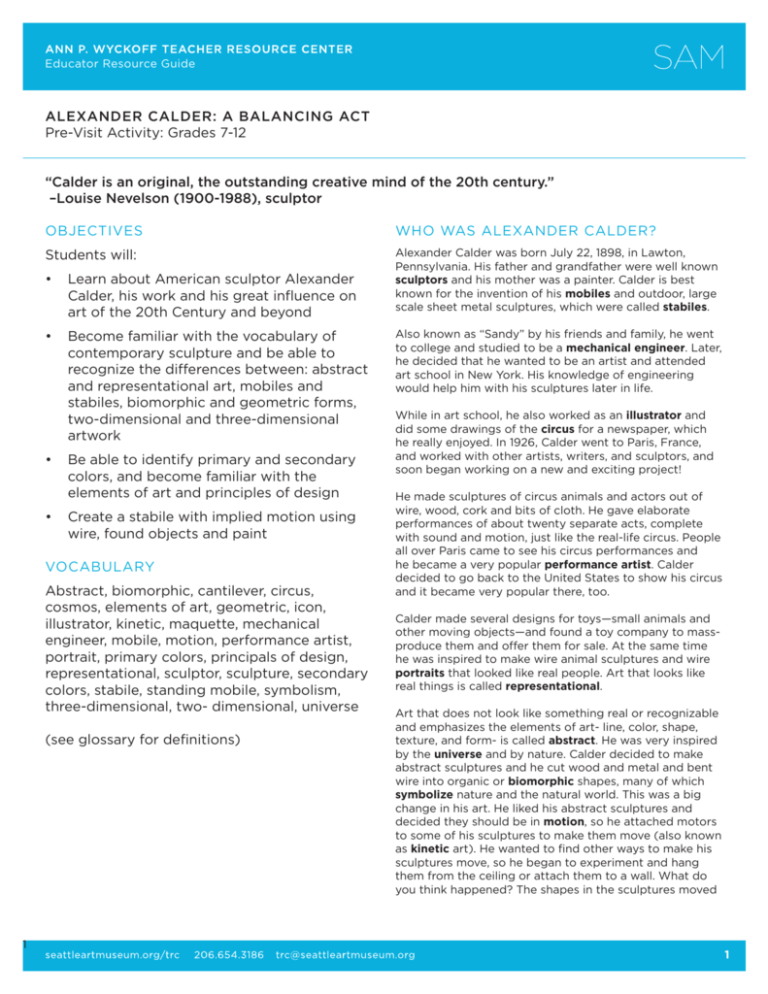
Educator Resource Guide ALEXANDER CALDER: A BALANCING ACT Pre-Visit Activity: Grades 7-12 “Calder is an original, the outstanding creative mind of the 20th century.” –Louise Nevelson (1900-1988), sculptor OBJECTIVES WHO WAS ALEXANDER CALDER? Students will: Alexander Calder was born July 22, 1898, in Lawton, Pennsylvania. His father and grandfather were well known sculptors and his mother was a painter. Calder is best known for the invention of his mobiles and outdoor, large scale sheet metal sculptures, which were called stabiles. • Learn about American sculptor Alexander Calder, his work and his great influence on art of the 20th Century and beyond • Become familiar with the vocabulary of contemporary sculpture and be able to recognize the differences between: abstract and representational art, mobiles and stabiles, biomorphic and geometric forms, two-dimensional and three-dimensional artwork • Be able to identify primary and secondary colors, and become familiar with the elements of art and principles of design • Create a stabile with implied motion using wire, found objects and paint VOCABULARY Abstract, biomorphic, cantilever, circus, cosmos, elements of art, geometric, icon, illustrator, kinetic, maquette, mechanical engineer, mobile, motion, performance artist, portrait, primary colors, principals of design, representational, sculptor, sculpture, secondary colors, stabile, standing mobile, symbolism, three-dimensional, two- dimensional, universe (see glossary for definitions) 1 Also known as “Sandy” by his friends and family, he went to college and studied to be a mechanical engineer. Later, he decided that he wanted to be an artist and attended art school in New York. His knowledge of engineering would help him with his sculptures later in life. While in art school, he also worked as an illustrator and did some drawings of the circus for a newspaper, which he really enjoyed. In 1926, Calder went to Paris, France, and worked with other artists, writers, and sculptors, and soon began working on a new and exciting project! He made sculptures of circus animals and actors out of wire, wood, cork and bits of cloth. He gave elaborate performances of about twenty separate acts, complete with sound and motion, just like the real-life circus. People all over Paris came to see his circus performances and he became a very popular performance artist. Calder decided to go back to the United States to show his circus and it became very popular there, too. Calder made several designs for toys—small animals and other moving objects—and found a toy company to massproduce them and offer them for sale. At the same time he was inspired to make wire animal sculptures and wire portraits that looked like real people. Art that looks like real things is called representational. Art that does not look like something real or recognizable and emphasizes the elements of art- line, color, shape, texture, and form- is called abstract. He was very inspired by the universe and by nature. Calder decided to make abstract sculptures and he cut wood and metal and bent wire into organic or biomorphic shapes, many of which symbolize nature and the natural world. This was a big change in his art. He liked his abstract sculptures and decided they should be in motion, so he attached motors to some of his sculptures to make them move (also known as kinetic art). He wanted to find other ways to make his sculptures move, so he began to experiment and hang them from the ceiling or attach them to a wall. What do you think happened? The shapes in the sculptures moved 1 Educator Resource Guide ALEXANDER CALDER: A BALANCING ACT Pre-Visit Activity: Grades 7-12 and changed positions in the wind! Calder called these new sculptures mobiles and history was made. Calder was pleased with his mobiles and they became very popular. He made sculptures called stabiles as well. These sat on the ground. Stabiles did not move and like his mobiles, they looked different from different directions as people walked around them. Some of his stabiles looked like they wanted to move! Calder also combined two of his art forms and put a mobile on top of a stabile. This new art form, called a standing mobile, had the moving parts of a mobile, but were attached to a base that did not move. As he got older, Calder’s work got bigger and he began making giant pieces of art for public spaces outdoors. He would plan for the large sculptures in his studio by first making maquettes, or small-scale models. The model would help Calder problem solve on how to build his really big sculptures. One of his largest sculptures in Italy is 60 feet tall! Calder’s art made him happy and he loved spending time with his wife, daughters, and grandchildren. He died in 1976 at the same time his work was being shown in a grand exhibition in New York City. Alexander Calder is considered an American icon, one of the most inventive and beloved artists of his time. His sculptural work has influenced artists for generations and continues to grace and delight audiences, and enlivens public spaces around the world. -Based on excerpts from The Life and Work of Alexander Calder by Schaefer, Adam (Chicago, IL: Heinemann Library, 2003). DISCUSS IT! Take a look at Alexander Calder’s sculpture, Rock, 1945 (page 9). • Would you consider this “representational” or “abstract”? Explain. (abstract: Calder uses art elements as mode of expression; and object is not recognizable) • How big do you think this sculpture is? (14 x 9 x unknown in.) • What if I told you that it does not move? Would you still think it looks like it wants to move? (implied motion, which is what students need to achieve with their projects) • Is it two-dimensional or is it threedimensional? Describe. (3D: height, width, depth, and can be viewed from different sides) • Calder was very influenced by shapes that occur in nature. Can you point out biomorphic shapes? Geometric shapes? (biomorphic: irregular, gently curved shapes) (geometric: circles, right angles, triangle) • What materials did Calder use? What kinds of tools do you think he used? (sheet metal, stone, brass, wire, paint) (metal sheers, pliers, metal snips, paint brush) • Which art elements are dominating? (line, shape, form, space) • How do you think Calder made this piece balance? Was there math involved? Or do you think it was intuitive? (utilized balance points, equilibrium) (Calder was an expert engineer and used his fingers as balancing points to problem solve. Typically, Calder used an intuitive process. Larger works required math.) • Does this piece look heavy? How has Calder given you the viewer the impression that this is light? (thin lines, use of open or negative space, simple delicate details and shapes) Now look at Calder’s Untitled, 1948 (page 10). • How do you think this relates to nature? (solar system, universe, orbital pattern) • Which art elements or principles of design does Calder utilize to convey his concept? (elements of art: line, shape, form, color, space) (principles of design: balance, rhythm, harmony, proportion, pattern, contrast, emphasis, variety) • Is it kinetic? Why? What does that do to the composition? (yes, because it actually moves) (movement changes the way the sculpture appears from every angle) 2 Educator Resource Guide ALEXANDER CALDER: A BALANCING ACT Pre-Visit Activity: Grades 7-12 DISCUSS IT! continued MATERIALS • How is physical balance achieved here? Visual balance? (physical: weight is equally • Book: Calder Sculpture (SAM library) distributed, also known as equilibrium) (visual: large, dark shapes balanced by smaller delicate shapes; harmony, unity or balance achieved through use of color) • How do you feel when you look at this piece in comparison to the other one? Do you like it? • Does this look like it wants to move? How would it move? (it moves, but the focus is on the implication of motion for the purpose of this project) MAKE IT! Using Alexander Calder’s work as inspiration, create a stabile or standing mobile that implies motion using the materials provided. Calder often used found objects to create art early in his career. He sometimes did so out of necessity because materials were scarce and expensive during the time (WWII, 19411945). Using a rough sketch to work from, and the materials provided, choose a partner and design a stabile or standing mobile that reflects Calder’s style. Refer to the elements of art and principles of design as you work together to complete a sculpture that sits on the ground, stays permanently balanced on its own and implies movement or has minimal parts that actually move. You and your partner will present your work to the class as part of a group critique. • Color copies of Rock (page 9) • Color copies of Untitled (page 10) • Color copies of The Universe (page 8) • Examples of a stabile and a standing mobile (completed by teacher) • Medium gauge aluminum wire (soft enough to bend, strong enough to hold shape) (craft store) • Pre-cut pieces of wood in various shapes, sizes and conditions (May be used as bases, can be painted and/or nailed into) • Nails (partly hammer into wood and wrap wire around) • Wire nippers, needle-nose pliers (craft or hardware store) • Red, blue, yellow, black and white paint (tempera) • Writing paper for written assignment • Newspaper (to use when painting) • Paint brushes and water cups • Pencils and Erasers • Sketch paper • Hammers • Scissors Prior to the activity have students collect an assortment of “found objects” (small rocks, bottle caps, sea glass, buttons, ceramic pieces, empty spools of thread, small tin cans- use your imagination!) 3 Educator Resource Guide ALEXANDER CALDER: A BALANCING ACT Pre-Visit Activity: Grades 7-12 BEFORE YOU START HOW TO Consider: First, the instructor introduces all tools and materials and highlights proper use and safety. Next, a demonstration should be given on how to cut, coil, and bend wire. • The overall size of your stabile or standing mobile. • Other than Calder’s work, what will we use as inspiration for our sculpture? (Ex. Something from nature: universe, planetary system, a tree, ocean) • If building a stabile, how will you imply motion or make your stabile look as if it wants to move? • If building a standing mobile, how will you select which parts will move and which won’t? • How will we make all of the pieces work together AND balance on its own? • You may add extra pieces of wire to your sculpture for reinforcement. • You may construct parts of your sculpture separately and attach them with bits of wire. • As a team, work together to plan your base. Will it be formed using wire or will we use the provided wood? Be creative! • Be patient when trying to balance your stabiles! It will take trial and error. • Have a list handy that includes the elements of art and principles of design to help guide you. 1. Choose a partner to work with. 2. Make sketches of your stabile or standing mobile and decide what materials you are going to use. 3. Begin building your sculpture. 4. Using your sketch as a guide, bend and shape wire to form the branches or arms of your sculpture. 5. Incorporate found objects into the design of your stabile or standing mobile. 6. You may add extra pieces of wire for stability or to create the appearance of heavier lines by layering the wire. 7. Make sure your sculpture is balanced and can stand on its own permanently and without any help! You may need to make a wire base and attach it to your sculpture, or mount it to a piece of provided wood as a base. Use your imagination! 8. Once your sculpture is assembled, how will you use color to complete it? Use the paint provided (red, yellow, blue, black, white). 9. Imagine you are going to exhibit your sculpture in a museum. The museum will need one written statement from both of you, which will be placed near your work. Reflect on the process of making your sculpture and write an artist’s statement. An artist’s statement is a short document written by the artist or artists in first-person, which provides a window into the artist’s world. Write as many paragraphs you need to include the following information: 4 Educator Resource Guide ALEXANDER CALDER: A BALANCING ACT Pre-Visit Activity: Grades 7-12 HOW TO continued • Begin your written statement with: We have collaborated and created a stabile inspired by the work of American sculptor, Alexander Calder. • Now explain in complete sentences using correct spelling and grammar (does not have to be in this order): • What style of art is your stabile? Is your piece symbolic? • How is color used? How is color used to emphasized or contrast? • How does your stabile imply movement? • How did you include found objects into your work? What purpose do they serve? • Briefly describe your source of inspiration (nature) and the creative process you both took to complete your sculpture. • How does each of you feel about your work? • Include a description of the materials you used, your names, and the dimensions. • Give your piece a title and use that as your heading. EXAMPLE OF AN ARTIST’S STATEMENT Flora + Fauna, 2009 Wire, wood, nails, paint, and glass bottles Sheila Jones and James Smith 10 x 10 x 5 in. We have collaborated and created a stabile inspired by the work of American sculptor, Alexander Calder. This abstract piece is symbolic of the rich habitat of plant life and animal species found in Belize. Central America brings to mind bright colors so we have used the primary colors red, yellow and blue. You will notice a large surface of black is used to contrast the brilliance of those pigments. We have used black to symbolize the effects of toxins on the environment. The curved lines imply movement, like the waves of water, and the glass bottles, or found objects, are a visual reminder of the evidence of toxic waste. We began sketching this piece and the ideas seemed to flow easily. Once we decided to use Belize as our inspiration we began building our stabile. We gathered all of the materials we needed and really enjoyed the process. We did, however, discover how frustrating it is to try and balance our stabile. After we realized we needed quite a bit more physical weight on the lower portion, as well as more contrasting colors, we were very pleased with the results. 5 Educator Resource Guide ALEXANDER CALDER: A BALANCING ACT Pre-Visit Activity: Grades 7-12 GLOSSARY Abstract: art that does not look like something real or recognizable and emphasizes the elements of art—line, color, shape, texture, and form—to express its subject Biomorphic shape: typically occurs in nature; also referred to as “natural” or “irregular” Cantilever: a projecting beam or member supported at only one end Circus: an arena often covered by a tent and used for variety shows usually including feats of physical skill, wild animal acts, and performances by clowns and animal tamers Cosmos: see universe Elements of art: the visual language of art which artists manipulate: line, shape, form, color, texture, value and space Geometric shape: a “regular” form that has straight lines including triangles, squares and circles Icon: an object or symbol of uncritical devotion Illustrator: an artist who depicts decorative or visual features intended to explain subject matter Principles of design: the fundamental concepts used to organize or arrange the structural elements of art- balance rhythm, harmony, proportion, pattern, contrast, emphasis, variety Representational: art that shows the way things look in real life Secondary colors: derived from mixing combinations of primary colors: orange, purple, green Sculptor: an artist who makes sculptures Sculpture: a statue or carving Stabile: a sculpture that does not move and looks different from different directions Standing mobile: a stabile that includes moving parts and looks different from all directions Symbolism: abstract ways of conveying ideas Three-dimensional: refers to artwork that has mass which includes height, width and depth, such as a wire sculpture that may be viewed by walking around it Two-dimensional: refers to artwork having only height and width, such as a drawing on the surface of a piece of paper which is “flat” Kinetic: refers to artwork that actually moves or implies movement Universe: the entire celestial cosmos Maquette: a small preliminary model of a planned sculpture BIBLIOGRAPHY Mechanical engineering: a branch of engineering concerned with the industrial application of mechanics and the production of tools, machinery, and their products Mobile: (mo-beel) a sculpture that is made of pieces that move, invented by Alexander Calder Motion: changing position or moving Performance artist: someone who presents a nontraditional art form often with political or topical themes that typically features a live presentation to an audience of onlookers and draws on such arts as acting, poetry, music, dance or visual arts Alexander Calder and His Magical Mobiles by Lipman, Jean and Aspinwall, Margaret. (New York, NY: Hudson Hills Press, Inc., 1981.) Key Art Terms for Beginners by Yenawine, Philip. (New York, NY: Harry N. Abrams, Inc., 1995.) The Essential Alexander Calder by Greenfield, Howard. (New York, NY: Harry N. Abrams, Inc., 2003.) The Life and Work of Alexander Calder by Schaefer, Adam. (Chicago, IL: Heineman Library, 2003.) Portrait: a representation of a person usually showing the face Primary colors: three basic colors with which all other colors are derived: red, yellow, blue. Color is used by artists as one of the elements of art, or the visual language of art 6 Educator Resource Guide ALEXANDER CALDER: A BALANCING ACT Pre-Visit Activity: Grades 7-12 WEBOGRAPHY ONLINE RESOURCES Alexander Calder (1898-1976). Calder Foundation, www.calder.org The following web sites not only examine Alexander Calder the person, but also provide useful images of his work. Glossary of definitions. (Merriam Webster), www.merriam-webster.com How to Write an Artist’s Statement. (Self-Representing Artists), www.ebsqart.com/ArtMagazine/za_400.htm Universe. (Image: NASA), www.nasa.gov/topics/solarsystem/index.html Calder Foundation www.calder.org This site includes complete biographical information clearly divided into periods as well as high quality, full screen images of many of his works accompanying each period. National Gallery of Art www.nga.gov/exhibitions/caldbro.shtm This site offers an excellent online tour of a Calder exhibit at the National Gallery of Art in Washington, D.C. San Francisco Museum of Modern Art www.sfmoma.org To get to the provided information on Calder, go to the home page and enter “Calder” in the search field. The site contains great quotes and information that accompany the images of his work. 7 Educator Resource Guide ALEXANDER CALDER: A BALANCING ACT Pre-Visit Activity: Grades 7-12 The Universe Image: NASA, www.nasa.gov/topics/universe/index.html 8 Educator Resource Guide ALEXANDER CALDER: A BALANCING ACT Pre-Visit Activity: Grades 7-12 Rock, 1945 Sheet metal, stone, brass, wire, and paint Alexander Calder American, 1898-1976 14 x 9 ½ x ?in. Collection of Jon and Mary Shirley, T2009.56.9 Photo: Julian Calder, © 2009 Calder Foundation, New York / Artists Rights Society (ARS), New York 9 Educator Resource Guide ALEXANDER CALDER: A BALANCING ACT Pre-Visit Activity: Grades 7-12 Untitled, 1948 Sheet metal, wire and paint Alexander Calder American, 1898-1976 10 1/2 x 37 x 12 in. Collection of Jon and Mary Shirley, T2009.56.15 Photo: Julian Calder, © 2009 Calder Foundation, New York / Artists Rights Society (ARS), New York 10

